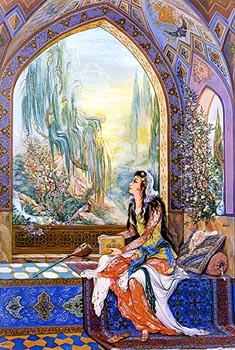
The links between Arabic literature and music are many, but can particularly be seen in a parallel fashion with the Mawwal, a form of sung poetry. Imagine the camp fires of the Bedouin late at night with the tribe all gathered around listening to a bard, or a musical poet, who sings songs of topics such as love, war, and comedy to an awaiting and eager audience. The Mawwal is one of the most enduring forms of Arab song to this day, so let’s take a look at what its format is and how it relates to Oriental Dance.
The Mawwal-The Sung Poetry of Arab Music
Introduction:
- The Mawwal is a colloquial form of sung poetry
- In Arabic music, the mawwāl (موال; plural: mawāwīl, مواويـل) is a traditional genre of vocal music that is usually presented before the actual song begins.
- It can be accompanied by instruments, or sung acapella with none
- In music, as the mawwal is sung at the beginning of a song, it is often started off with a layali, (ليالي), in which the listener will hear the common phrase “Ya Ain Ya Lail” (يا عين يا ليل), which means “Oh eye, Oh night.” , that uses melismatic (sliding up and down a note) vocals to stress the vowels of the words the singer is emphasizing
- The poetic form of the mawwal varies from region to region, and from singer to singer
- In popular music, the mawwal has been shortened and adapted, such as in songs of the popular Egyptian singer, Abdel Halim Hafez, in songs such as “Sawwah” (a great example of a traditional Mawwal), and “Qariat Al Finjan” (a modern version of Mawwal).
Classical Literature Poetic Forms:
- In Ottoman court literature, there were 9 systems of poetry created out of 4 syllabic structures:
- Closed syllables (ben, gel, kar, tez)
- Open syllables (tepe, kara, gibi, karhur)
- One open, one closed syllables (gonul, kalem, sepet, kerem)
- One closed, one open syllables (bade, lale, nale, terle)
- 9 systems of poetry:
- Qaside–praise poetry, for Sultan; protection from powerful man
- Nesibe-introduction
- Girizgih–taking off place
- Medhiyye–praise
- Tegazzul– inclusion of a qazal (love poem)
- Fahriyye–self-praise
- Du’a–prayer
- The qaṣīdaᵗ (also spelled qaṣīda; in Arabic: قصيدة, plural qasā’id, قــصــائـد; in Persian: قصیده or چكامه, chakameh, in Turkish: kaside), is a form of lyric poetry that originated in pre-Islamic Arabia. Well known qasā’id include the Qasida Burda (“Poem of the Mantle”) by Imam al-Busiri and Ibn Arabi’s classic collection “The Interpreter of Desires”.
- As the qaside is a form that has descended from Pre-Islamic Arabic poetry, it has been adapted by such musicians as Egyptian legendary songstress, Om Kulthum, in her famous song, Al Atlal, “The Ruins”.
- The classic form of qaside maintains a single elaborate metre throughout the poem, and every line rhymes. It typically runs more than fifty lines, and some times more than a hundred. It was adopted by Persian poets, where it developed to be some times longer than a hundred lines.
- Qaside means “intention” and the genre found use as a petition to a patron. A qasida has a single presiding subject, logically developed and concluded. Often it is a panegyric, written in praise of a king or a nobleman, a genre known as madīḥ, meaning “praise”.
- In his ninth century “Book of Poetry and Poets” (Kitab al-shi’r wa-al-shu’ara’) the Arabian writer ibn Qutaybah describes the (Arabic) qasida as formed of three parts;
- a nostalgic opening in which the poet reflects on what has passed, known as nasib. A common concept is the pursuit by the poet of the caravan of his beloved: by the time he reaches their camp-site they have already moved on.
- a release or disengagement, the takhallus, often achieved by describing his transition from the nostalgia of the nasib to the second section, the travel section or rahil, in which the poet contemplates the harshness of the land and life away from the tribe.
- the message of the poem, which can take several forms: praise of the tribe (fakhr), satire about other tribes (hija) or some moral maxim (hikam).
- While many poets have intentionally or unintentionally deviated from this plan it is recognizable in many.
- From the 14th century CE Persian poets became more interested in ghazal and the qasida The ghazal developed from the first part of qasida in which poets praised their sweethearts. Mystic poets and Sufis used the ghazal for mystical purposes.
- In Egypt, the musicians of Mawawil play the rabab (a double-stringed spike fiddle made from half of a coconut shell covered with fish skin and a bow strung with horse hair), the kawala (an end-blown, oblique flute with six holes) and the arghoul (an ancient double clarinet characterized by two pipes of unequal length. The second pipe serves as a drone and can be lengthened by adding pieces.
- The player uses the technique of circular breathing to produce an uninterrupted sound). The arghoul can be traced back to Pharaonic times as it is exactly depicted on wall paintings of the temples of the third dynasty. Amin Shahin is one of the few remaining arghoul players in Egypt, since the death of arghoul master, Moustafa Abd al Aziz in 2001.
- Mawwal is sung by powerful singers who are able to demonstrate strong vocal capabilities. The most famous singers come from Lebanon in specific, Sabah, Wadih- al Safi and Fairouz. However nowadays, some of the most famous and strongest singers that can sing mawaweels are Najwa Karam and Wael Kfoury
Arabic Language and Script, and Oriental Dance:
- Arab language is made of up the jeddar (consonant patterns), and the wazun (vowel patterns)
- Arabic vocal music is characterized by melisma, or the sliding up and down a vowel on a note to create a certain asthetic indicative of the genre or the personal style of the singer, for instance, the layali genre of singing
- Arabic dance, particularly raqs sharqi, or “oriental dance”, which is the solo improvised women’s dance that was codified in the Ottoman courts, follows the curves in the shape of the letters of Arabic script
- Arabic music is taught in the jeddar and wazun theory, as well
- The stillness and breathe that is indicative of true oriental style can be seen in the jeddar patterns, where a dancer is holding a position, while layering
- The arabesque curving patterns can be seen in the sliding and twisting qualities of the melismatic wazun vowel patterns
- The different schools of Arabic calligraphy show the different types of curves and line patterns







